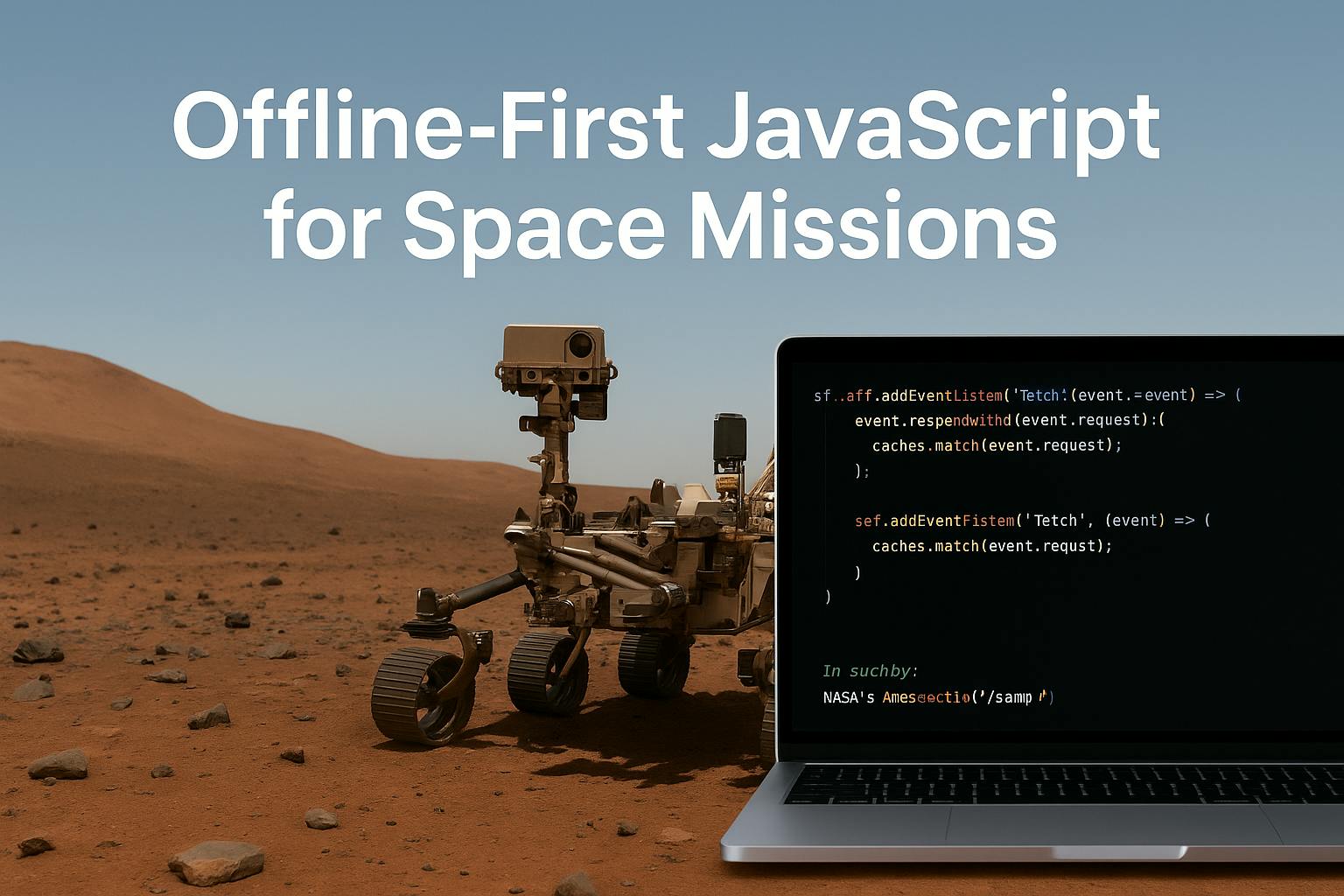Whenever we think about javascript we imagine websites, web applications, browser based games but javascript has quietly evolved beyond the web.Today, it's even orbiting our planet—and in some cases, headed to Mars. In environments where internet connectivity is a luxury, JavaScript is proving its worth as an offline-first language.
This article explores how JavaScript is used in space missions, the challenges it solves in remote environments, and how developers can draw inspiration from these high-stakes use cases to build more resilient apps.
Now, let’s understand why offline-first is important in Space?
There are Spacecraft, satellites, and interplanetary rovers operate in extreme conditions:
- No real-time internet
- High latency (up to 40 minutes delay betweenEarth and Mars)
- Hardware limitations
- Power and memory constraints
Now, any of the software running in these systems must be
-
Self-reliant
-
Resilient to connection drops
-
Capable of local decision-making
-
Able to sync data when possible
In such a scenario, JavaScript’s lightweight nature, ecosystem, and offline-capable design patterns make it surprisingly useful.
Let’s talk about some real use case of the space flow,
Real Use Case: NASA's Open MCT
One of the most prominent JavaScript-based tools in space exploration is
Open MCT (Mission Control Technologies), developed by NASA.Now let’s understand what is that?
-
A web-based platform for mission planning, telemetry visualization, and data monitoring.
-
Built with JavaScript, HTML, and CSS.
-
Designed to work offline, allowing ground operators to continue monitoring spacecraft without internet access.
This is Used by:
-
NASA's Ames Research Center
-
ESA (European Space Agency)
-
Commercial space startups
Its modular design allows teams to customize the interface and logic for specific missions—whether you're watching a Mars orbiter or a CubeSat in low Earth orbit.
Explore Open MCT: https://github.com/nasa/openmct
Now, let’s understand why we are using JS in space?
Why Use JavaScript in Space?
We all have wondered why they chose JS instead of C/C++ in the tech space?
- Ease of development
- Fast prototyping for dashboards and tooling.
- Cross-platform
- Runs in browsers and Node.js environments.
- Massive ecosystem
- Use existing libraries to handle logs, charts, caching, etc.
- Offline capabilities
- Service workers, IndexedDB, and localStorage**.**
While low-level systems in spacecraft often use C or Ada, mission control tools, simulators, and dashboards are increasingly JS-powered.
Here is the quick comparison with C with JS:
- Ease of development
|
Feature |
Javascript |
C/Ada |
|---|---|---|
|
Use Case |
Dashboard, tools |
Onboard spacecraft logic |
|
Development Speed |
Fast |
Slower, requires more setup |
|
Platform independence |
High(nodejs) |
Lower |
|
Ecosystem |
Massive(npm) |
Niche |
|
Offline capable design |
Yes |
Depends on system |
Cool, that's very nice.
Can you tell me what techniques can be use in space?
So, there are many techniques they can use in space but we will mainly focus on 5 techniques.
Let’s get start now.
Offline-First JS Techniques for Space
-
Service Workers for Caching
Let’s understand what is that?
Service workers allow caching files and API responses for offline access.
self.addEventListener("fetch", (event) => {
event.respondWith(
caches.match(event.request).then((response) => {
return response || fetch(event.request);
})
);
});
Perfect for telemetry dashboards where continuous internet isn’t guaranteed.
Now, let’s see how offline data logging is doing in JS.
-
Intermittent Sync Strategies
Hey What’s this Intermittent sync strategy?
let me explain to you about it so we all know that Space has very limited communication ways correct? Now in this case there are some strategies which can help here so that delta sync, data compression, and edge caching can reduce the time spent transferring data once a connection is re-established and it’s very crucial for high-latency environments like deep space.
3. Fault Tolerance and Redundancy
Space systems must anticipate failures. JavaScript applications can:
- Use Retry Logic for failed API calls.
- Implement Circuit Breaker Patterns to prevent system overloads.
- Use Event Sourcing to maintain a record of all changes, allowing recovery after failures.
4. Data Prioritization and Compression
Not all data is equally important. JS systems can prioritize critical telemetry and compress non-essential data to ensure the most important information reaches mission control.
// Example: Compressing JSON data before sending
const data = { status: 'OK', battery: '85%', signal: 'strong' };
const compressed = JSON.stringify(data).replace(/\s+/g, '');
This approach minimizes data size, reducing transmission costs and time.
5. Data Prioritization
When bandwidth is limited, not all data is equal. Systems tag and queue data by priority:
-
Life-support > scientific readings > diagnostics
-
High-priority packets are synced first
Javascript on Edge Devices in Space
In Space missions often include sensors or edge devices with low computing power. Surprisingly, JS fits here too:
- Node.js on Raspberry Pi Zero (used in CubeSats)
- JavaScript runtimes on microcontrollers (e.g., Espruino, Moddable)
They handle tasks like:
- Gathering sensor data
- Triggering alerts
- Buffering telemetry for future sync
Example: A Raspberry Pi in a weather balloon logs atmospheric data with a Node.js app, stores readings in IndexedDB, and dumps to SD card for later analysis.
Lessons Earth Developers Can Learn
Offline-first JS isn't just for space—it benefits any environment with unreliable internet:
- Remote villages
- Field work apps
- Healthcare tools
- Games with offline progress tracking
If it works on Mars, it'll work anywhere.
-
Progressive Web Apps (PWAs)
-
Local-first databases
-
Caching and sync patterns
These ideas improve reliability, performance, and UX—whether you're in orbit or on a bus
Conclusion
The development of JavaScript from web page scripting to space mission technology represents an impressive transformation. The language demonstrates its growth and adaptability through this development. The study of JS operations in space enables us to develop applications that handle unpredictable conditions while delivering user satisfaction and creating a more resilient web and beyond.


